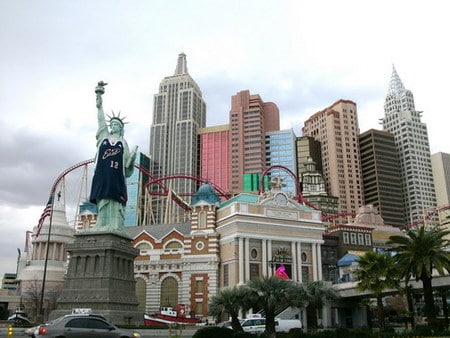In Chicago, a billboard grows lettuce. In Las Vegas, even the statues support the NBA All Star game. In Los Angeles, an entire building exterior becomes an advertisement. And in New York City, pedestrians hear a voice inside their heads, coming from a wall mural.
Across the country, out-of-home advertising is becoming the most innovative, cutting-edge media in the marketplace. When coupled with the fact that outdoor advertising has enjoyed revenue growth rates far in excess of the overall ad industry in recent years, it’s a combination that sparks optimism across the marketplace.
A more mobile society
The reasons for out-of-home’s growth are numerous. Clearly, other traditional media are suffering from fragmentation and audience erosion. Since the 1970s, the number of television networks has increased from the former Big Three to hundreds. With the advent of HD radio, satellite radio, and other audio innovations, the number of choices in the over-the-air marketplace has multiplied exponentially. Magazine titles continue to increase as well. The end result is a fragmentation of media, making it more difficult to reach consumers. No longer can you expect to reach a majority of Americans by simply placing a commercial during the most popular shows on television. This year, virtually all forms of traditional, in-home media have experienced a decline in revenues and audience. In the case of spot radio, that decline is in the double digits. Costs per thousand (CPM) for traditional, in-home media, however, have not necessarily declined at a rate equal to their decreased reach. Average CPMs remain high, reducing the cost effectiveness of television, print, and even radio buys.
This trend is made even more apparent as ways to avoid advertising multiply. DVRs (digital video recorders), which are already in more than 20 percent of US households according to many analysts, are short-circuiting television commercials as consumers now have the option of simply fast forwarding through ads. Satellite radio, with a business model based on subscribers, offers a commercial-free alternative to traditional radio. The combination of factors is significantly reducing the way traditional media reach consumers. Changing American habits are also contributing to the decline. Newspapers, once a necessary part of most American’s routine, are declining. Circulation is down for most of the major US dailies. The venerable Sunday edition of The New York Times has seen a drop in circulation of nearly nine percent this year alone. Clearly, the Internet is having an impact on media. News-reading habits are shifting online. The Internet is still experiencing growth in advertising dollars and choices, but the fragmentation there is high. While flagship websites, such as the aforementioned Times, see hits in the hundreds of thousands or even millions, it’s still difficult to reach a target audience with banner ads and pop-ups. Additionally, the way Americans spend their time has changed over the last 10 to 15 years. Commutes are getting longer. As real-estate prices rose in nearby communities, the “exurbs” became more popular places to live. While a 15-minute commute was once common, commutes of an hour or more are now the norm for millions of people. Mass-transit ridership is up, as Americans attempt to mitigate rising gas prices. Health-conscious consumers are choosing to bike or walk.
The combination of factors causes Americans to be out of the home for longer periods of time, often nearing 12 hours a day. Increased working hours lead to more time spent away from the home. The sum total is a more mobile, less homebound society-all of which leads to less time spent with in-home media. All of these factors play into the growth of out-of-home advertising. It is the one medium that cannot be clicked off, fast-forwarded through, or channel changed. It’s seen 24 hours a day, seven days a week. It’s ubiquitous, difficult to ignore, and exceedingly effective, as proven in case study after case study. Its CPMs are still the most cost effective among all forms of advertising media-less than half that of its closest competitor, radio. Outdoor advertising is also reaching consumers in places where they are making decisions about what to purchase and what services to use. Rather than advertising a car at night when consumers are thinking about families and sleep, billboards promoting the latest models reach consumers when they are driving. People in doctors’ offices are being exposed to out-of-home video networks advertising health services when people are thinking about their health. New avenues for outdoor advertising are presenting a powerful, place-based marketing tool which advertisers are recognizing and using.
Advertisement
Technological innovation
Technology tends to confound many traditional forms of media. Outdoor, however, is different: As new technologies come online, outdoor is adapting to them and using them to find new ways to surprise and delight consumers.
Bluetooth: With Bluetooth technology becoming standard on cell phones, outdoor-advertising companies are taking advantage. Bus shelters, transit posters, mall kiosks, and other outdoor formats are enhancing their physical structures with transmission equipment capable of pushing content to Bluetooth devices.
In one example, commuters at Grand Central Station in New York City were given the option of downloading trailers to popular CBS television shows through their phones when they walked by transit posters advertising the programs. Bus shelters are also taking advantage of the technology. Bluetooth continues to grow as the physical infrastructure of the technology is built out, indicating this will be a growth area for years to come.
SMS: Text messaging (aka SMS, for “short message service”) continues to grow in popularity, with Americans sending millions of text messages every year. Out-of-home advertising is combining digital technology with SMS to engage consumers in new ways. A Nike advertisement in Times Square, for instance, allowed pedestrians to design their own sneakers on a billboard using their phones as a controller; they could then send the design to Nike and purchase the one-of-a-kind product.
And in an award-winning campaign for BBC World, passersby were encouraged to text votes to a billboard presenting provocative questions about major news stories of the day. For example, a picture of American troops in Iraq was accompanied by a choice: occupiers or liberators. The vote tallies were then included on dynamic signage that formed part of the board.
SMS presents a unique way to engage the consumer without being intrusive. By engaging with the advertisement, consumers are more likely to remember the message, making this a particularly powerful addition to outdoor advertising’s toolbox.
Advertisement
Digital: But perhaps the biggest change to hit the outdoor advertising industry since the advent of computerized printing of vinyls is digital technology. Digital is revolutionizing the way content is displayed on billboards and other formats. LED (light emitting diode) screens are allowing billboards to be updated nearly instantaneously by computer, rather than requiring billposters to replace copy.
Digital is also making its way into other out-of-home formats. Out-of-home video networks continue to deploy, from subway stations to health clubs to gas stations. Traditional media are using new technology to attract a great deal of attention, an advertisement for the A&E series, “Paranormal State” used cutting-edge audio technology to beam micro-pulse sound waves at a specific area of the sidewalk near the campaign’s wallscape to literally whisper in the ears of individual pedestrians.
Airports are also undergoing a transformation, as digital technology is being used to dramatic effect. The captive audience in airports is viewed as a major prize to advertisers, as business travelers make up the majority of the viewing audience. Digital has led to touch screens in some terminals and a digital “immersion” corridor in New York’s JFK International Airport, where consumers were literally surrounded by content promoting a software manufacturer.
In all of these examples, tried-and-true outdoor formats were upgraded by technology, creating an entirely new experience for the consumer. Yet other areas are seeing entirely new forms of advertising.
In Chicago and New York City, among other localities, advertisers are turning to vacant (or even occupied) storefronts to attract attention at eye level. These storefront ads can be up to a city block long, such as a New York installation for the new television series, “Fringe.” By using underutilized window space, outdoor advertising is finding ways to survive and thrive in areas with limited billboard inventory or other, traditional forms of outdoor advertising.
Environmental initiatives
Companies throughout the out-of-home market are looking to become more eco-friendly.
Advertisement
Single sheet PE and PP posters are designed for recycling, which represents a significant reduction in the amount of waste being deposited in landfills. PE and PP posters can be converted into a reusable raw material, and outdoor advertising companies are beginning to take notice. The Outdoor Advertising Association of America is working with industry leaders to outline recycling plans, which can help turn used posters into new products.
Billboards themselves are also being turned into eco-friendly installations. A transition to LED lights from halogen lamps reduces energy consumption by 50 percent. Many billboards lit by four halogen lamps are now being lit by advanced lamps that only require two to adequately illuminate the entire board.
In some cases, billboards themselves are even being turned into power-generating plants. A pilot program underway in Florida and a similar pilot in San Francisco use solar panels mounted on the billboards to generate power to light the billboard. These systems contribute to the powering of billboards during the day, providing a clean source of power to help reduce dependence on fossil fuels.
Bus shelters in Chicago are also using solar power to handle lighting demands, and rainwater collection systems to provide water for cleaning and maintenance tasks.
Also in development are wind turbines mounted between billboard faces. These wind turbines would serve much the same purpose as the solar panels, providing enough power to light the billboards.
A bright future
So outdoor advertising is not only one of the oldest mass media, it’s also one of the hottest. Its annual revenue growth is second only to the Internet and it’s likely to remain that way for some time to come.
Consumer habits are changing in a permanent way, making them more receptive to outdoor advertising. Technology is helping, not hurting the industry, in contrast to many other media. The medium is expanding into new areas and re-invigorating traditional forms. And by becoming more environmentally friendly, the medium is maintaining its place as a responsible corporate citizen encouraging many “green” advertisers to continue to do business with the industry.
For advertising companies, this means outdoor will figure into comprehensive media plans. For consumers, it means the increased potential to learn about new products in those locales where they are most likely to consider making purchases. And for businesses using outdoor, it means better return on investment and an increase in sales.
Stephen Freitas is the chief marketing officer for the Outdoor Advertising Association of America (www.oaaa.org).


 Best of Wide Format2 months ago
Best of Wide Format2 months ago
 Best of Wide Format2 months ago
Best of Wide Format2 months ago
 Blue Print3 weeks ago
Blue Print3 weeks ago
 Best of Wide Format2 months ago
Best of Wide Format2 months ago
 Best of Wide Format2 months ago
Best of Wide Format2 months ago
 Best of Wide Format2 months ago
Best of Wide Format2 months ago
 Best of Wide Format2 months ago
Best of Wide Format2 months ago
 Best of Wide Format2 months ago
Best of Wide Format2 months ago















